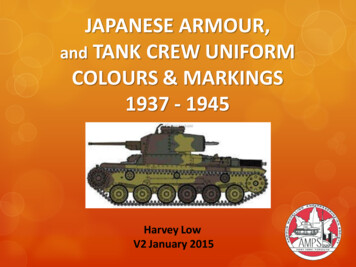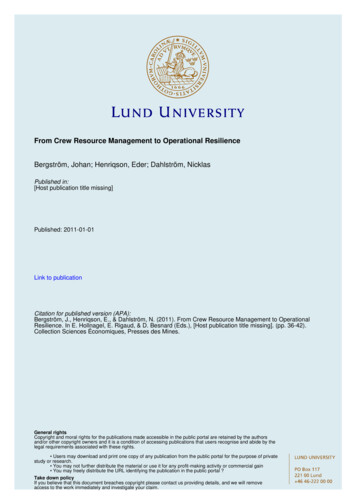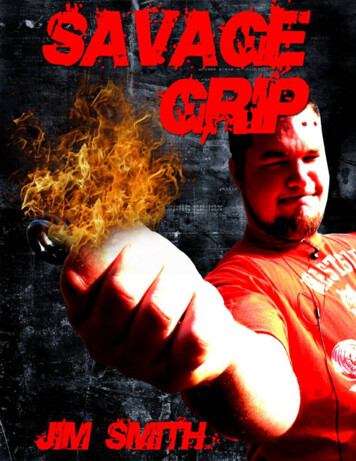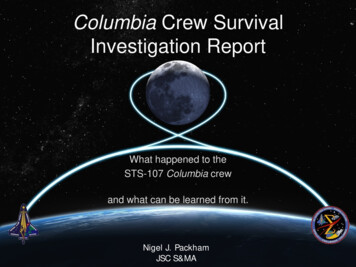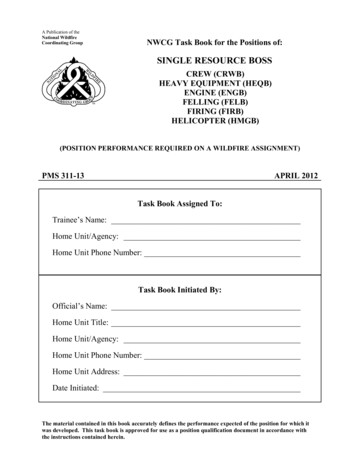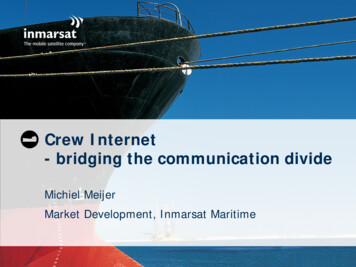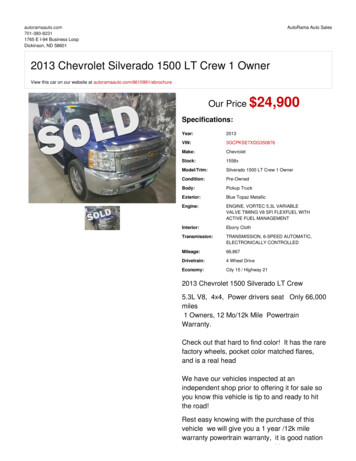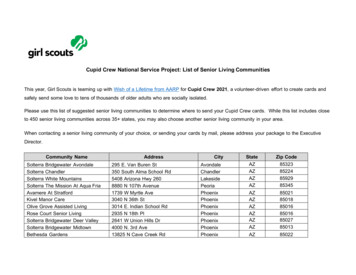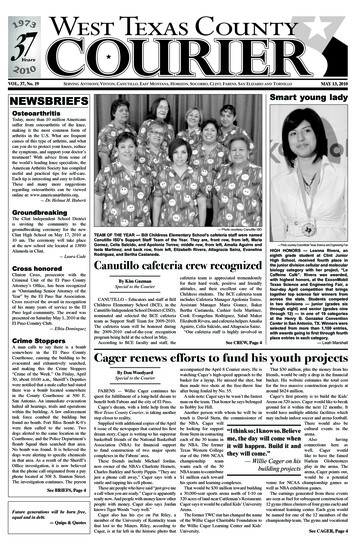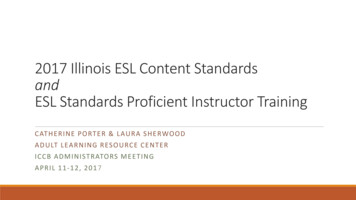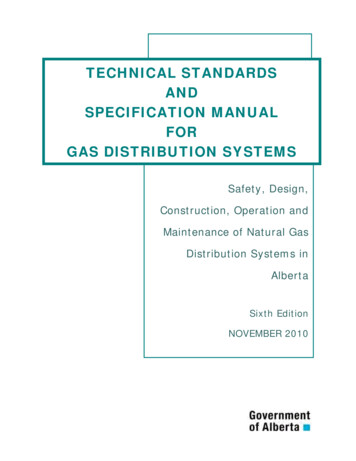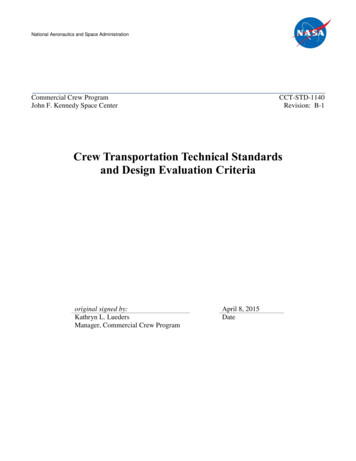
Transcription
National Aeronautics and Space AdministrationCommercial Crew ProgramJohn F. Kennedy Space CenterCCT-STD-1140Revision: B-1Crew Transportation Technical Standardsand Design Evaluation Criteriaoriginal signed by:Kathryn L. LuedersManager, Commercial Crew ProgramApril 8, 2015Date
Crew Transportation Technical Standardsand Design Evaluation CriteriaCCT-STD-1140Revision: B-1Record of ptionExport Control marking and links removed for STIUpdates per CR 0175 to align with CCT-REQ-1130. Changesinclude references to AE9 and AP9, FAA AC 20-136B, JSC65827A, JSC 65828B-1, NASA-STD-4003A, and ORDEM 3.0; anda minor change in Section 7.5.3.Update Appendix BEditorial updates per CCP CR0090.Editorial updates per CCP CR0045.Baselines Crew Transportation Technical Standards and DesignEvaluation Criteria.Commercial Crew 07/201212/8/2011Page 2 of 86
Crew Transportation Technical Standardsand Design Evaluation CriteriaCCT-STD-1140Revision: B-1Table of Contents1.0INTRODUCTION. 41.11.21.31.42.0PURPOSE . 4SCOPE . 5PRECEDENCE. 5DELEGATION OF AUTHORITY . 5DOCUMENTS. 62.12.2REQUIREMENTS APPLICABILITY MATRIX . 6REFERENCE DOCUMENTS . 113.0BACKGROUND . 164.0SAFETY AND MISSION ASSURANCE . 184.14.25.0INTEGRATED ANALYSIS . 195.15.25.35.45.55.65.76.0AVIONICS AND ELECTRICAL SYSTEMS . 30EEE (ELECTRICAL, ELECTRONIC, AND ELECTROMECHANICAL) PARTS MANAGEMENT . 40MECHANICAL SYSTEMS . 41STRUCTURES . 45FLUID SYSTEMS . 49PROPULSION SYSTEMS . 55TRAILING DEPLOYABLE AERODYNAMIC DECELERATOR . 57MATERIALS, PROCESSES, AND FRACTURE CONTROL . 608.18.28.39.0GROUND SUPPORT EQUIPMENT. 29LAUNCH VEHICLE, SPACECRAFT, AND CREW SYSTEMS DESIGN . 307.17.27.37.47.57.67.78.0MODELS AND SIMULATIONS . 19STRUCTURAL DYNAMICS ANALYSIS, LOADS, AND MODELS . 20INTEGRATED VEHICLE DYNAMICS ANALYSIS . 22FLIGHT MECHANICS AND GN&C . 23INTEGRATED ABORT ANALYSIS . 25THERMAL CONTROL ANALYSIS AND MODELS . 26AEROSCIENCE . 27GROUND SUPPORT EQUIPMENT . 296.17.0SAFETY STANDARD FOR EXPLOSIVES, PROPELLANTS, AND PYROTECHNICS . 18SAFE USE OF LASER DIODE AND LED SOURCES . 18FRACTURE CONTROL . 60MATERIALS AND PROCESSES . 61NATURAL ENVIRONMENTS . 61SOFTWARE . 649.1FLIGHT AND GROUND SOFTWARE . 64APPENDIX A: ACRONYMS . 66APPENDIX B: 1100 SERIES DEFINITIONS . 68APPENDIX C: GUIDANCE FOR CRITICAL MODELS AND SIMULATIONS . 79Commercial Crew ProgramPage 3 of 86
Crew Transportation Technical Standardsand Design Evaluation CriteriaCCT-STD-1140Revision: B-11.0 IntroductionUnder the guidance of processes provided by Crew Transportation Plan (CCT-PLN-1100), thisdocument with its sister documents, Crew Transportation Technical Management Processes (CCTPLN-1120), International Space Station (ISS) Crew Transportation and Services RequirementsDocument (CCT-REQ-1130), Crew Transportation Operations Standards (CCT-STD-1150), and ISS toCommercial Orbital Transportation Services Interface Requirements Document (SSP 50808), providethe basis for a National Aeronautics and Space Administration (NASA) certification for services to theISS for the Commercial Provider. When NASA Crew Transportation System (CTS) certification isachieved for ISS transportation, the Commercial Provider will be eligible to provide services to andfrom the ISS during the services phase of the NASA Commercial Crew Program (CCP).1.1 PurposeIn the course of over fifty years of human space flight, NASA has developed a working knowledge andbody of standards that seek to guide both the design and the evaluation of safe designs for spacesystems. The purpose of this document is to inform potential Commercial Providers of thespecifications, standards, and products/artifacts that NASA considers crucial to a successfuldevelopment effort and to provide the Commercial Provider with NASA expectations, essentially thetechnical criteria, used in assessing these items to ensure they meet the intent of Sections 3.9 through3.12 of CCT-REQ-1130.The evaluation of technical standard requirements that utilize the "meet the intent of" language areaddressed in this volume and may be satisfied through the use of alternative standards instead of theNASA, military, or industry standard listed. For these alternative standards, this document will beutilized to define the evaluation criteria that the CCP will use to determine whether the proposedstandard is acceptable.Discipline specific technical work products/artifacts (e.g., plans, analyses, reports, etc.) are also calledout in this volume, along with the criteria that will be used to evaluate them. The intent is to identifyproducts that NASA deems critical to the ultimate successful certification of a CTS. It is NASA’sexpectation that any Commercial Provider’s successful development activities would already involvethese products. It is not NASA’s intent to convey a request for formal deliverables by listing these itemsin the technical products section of this document.This document is organized by discipline, with each section containing the key products and technicalassessments that will be used as a benchmark to determine acceptability of the Commercial Provider’stechnical standards and products.Once the Commercial Provider and NASA have reached an agreement on an alternative technicalstandard, it will be added to the partnered set of standards for the CTS. Once this partnered set ofstandards is in place, it will be used in design evaluations in lieu of the standard called by CCT-REQ1130. The content of this document will continue to be utilized as a reference for the types of productsand analysis that are typically evaluated to establish technical adequacy for each discipline.Commercial Crew ProgramPage 4 of 86
Crew Transportation Technical Standardsand Design Evaluation CriteriaCCT-STD-1140Revision: B-11.2 ScopeThis document includes the criteria, expectations, and insight criteria that will be used in the evaluationof technical standards for launch vehicle, spacecraft, and ground system requirements identified by theCCP and the ISS Program for the CTS. The CTS refers to all assets and services necessary to meet therequirements of CCT-REQ-1130, including pre-flight planning, trajectory and abort analysis, groundprocessing and manufacturing, ground operations, mission control, training, launch control, launch, onorbit operations, post-landing recovery operations, safety and mission assurance, and all other functionsrequired for safe and successful human space flight missions. When elements of the CTS are technicalor specific to a requirement, they will be called out; for example, the term CTS spacecraft will be usedwhen the launch vehicle and ground elements are not specific to that portion of the design.1.3 PrecedenceIn the event of a conflict between the text of this document and references cited herein (listed in Section2.0), the text of this document takes precedence. The exception to this statement is for SSP 50808,which takes precedence during the arrival, docked, and departure operations. Nothing in this documentsupersedes applicable laws and regulations, unless a specific exemption has been obtained.1.4 Delegation of AuthorityThis document was prepared by NASA’s CCP, and will be maintained in accordance with standards forCCP documentation. The CCP is responsible for assuring the definition, control, implementation, andverification of the requirements identified in this document.Commercial Crew ProgramPage 5 of 86
Crew Transportation Technical Standardsand Design Evaluation CriteriaCCT-STD-1140Revision: B-12.0 Documents2.1 Requirements Applicability MatrixThe table below indicates where in this document a discipline has documented the evaluation that willbe performed of the Commercial Provider’s technical standard to determine if it meets the intent of thelisted NASA or industry standard. This table also includes references to the appropriate section of CCTREQ-1130 where that standard is specified.DocumentNumberRevisionTitle and D-1140DescriptionANSI/ESD S20.20Edition077.1.8.27.2.2Avionics andElectricalSystemsEEE PartsManagementFAA AC 20-136BRev. B7.1.7.2GEIA-STD-0005-1BaselineAvionics andElectricalSystemsPrinted WiringBoards TechnicalAssessmentGEIA-STD-0005-2BaselineIEC 61000-4-2Edition2.0For the Development of anElectronic Discharge ControlProgram for Protection ofElectrical and ElectronicParts, Assemblies andEquipment (ExcludingElectrically InitiatedExplosive Devices)(R.CTS.286)Aircraft Electrical andElectronic System LightningProtection (R.CTS.290)Performance Standard forAerospace and HighPerformance ElectronicSystems Containing LeadFree Solder(R.CTS.277)Standard for Mitigating theEffects of Tin Whiskers inAerospace and HighPerformance Electronics(R.CTS.278)ElectromagneticCompatibility (EMC) Testingand MeasurementTechniques-ElectrostaticDischarge Immunity Test forHuman Body Model (HBM)Subassemblies, Assembliesand Equipment DischargeLevels(R.CTS.371)Commercial Crew Program7.1.5.27.2.2EEE PartsManagement7.1.8ElectrostaticControlsPage 6 of 86
Crew Transportation Technical Standardsand Design Evaluation CriteriaDocumentNumberIPC J-STD-001ERevisionRev. EIPC J-STD-001ESAmendment 1IPC-2152BaselineIPC-2220 Series2221: A2222: A2223: B2224: BL2225: BL2226: BL6011: BL6012: C6013: B6015: BL6016: BL6017: BL6018: ARev. E(1/1/04)IPC-6010 SeriesIPC-CM-770EJSC 20793Rev. CJSC 62809Rev. DJSC 65827Commercial Crew ProgramACCT-STD-1140Revision: B-1Title and CCT-REQ-1130RequirementRequirements for SolderedElectrical and ElectronicAssemblies(R.CTS.275 and R.CTS.276)Space Applications ElectronicHardware Addendum to JSTD-001E, Requirements forSoldered Electrical andElectronic Assemblies(R.CTS.275 and R.CTS.276)Standard for DeterminingCurrent Carrying Capacity inPrinted Circuit Board Design(R.CTS.270)Family of Printed BoardDesign T-STD-1140DescriptionAvionics andElectricalSystems7.1.5.2Avionics andElectricalSystems7.1.5.2Avionics andElectricalSystems7.1.5.2Avionics andElectricalSystemsFamily of Printed BoardPerformance Documents(R.CTS.269)7.1.5.2Avionics andElectricalSystemsComponent MountingGuidelines for Printed Boards(R.CTS.284)Crewed Space Vehicle BatterySafety Requirements(R.CTS.282)Human-Rated SpacecraftPyrotechnic Specification(R.CTS.294)7.1.5.2Thermal Protection SystemDesign Standard forSpacecraft(R.CTS.293)7.4.3.1Avionics andElectricalSystemsAvionics andElectricalSystemsInterconnectingCable 1.47.1.37.3.2Page 7 of 86
Crew Transportation Technical Standardsand Design Evaluation CriteriaDocumentNumberJSC 65828RevisionJSC 65829CCT-STD-1140Revision: B-1Title and CCT-REQ-1130RequirementStructural DesignRequirements and Factors ofSafety for e7.4.3.17.4.17.5.27.6.2ALoads and StructuralDynamics Requirements forSpaceflight Hardware(R.CTS.297)5.2.25.3.15.3.27.5.27.6.2JSC 65985Rev. A7.7.2MIL-STD-461Rev. FMIL-STD-464Rev. CMIL-STD-981Rev. /90)NASA-STD-4003AARequirements for HumanSpaceflight for the TrailingDeployable AerodynamicDecelerator (TDAD)(R.CTS.291)Requirements for the Controlof ElectromagneticInterference Characteristicsof Subsystems and Equipment(R.CTS.287)ElectromagneticEnvironmental EffectsRequirements for Systems(R.CTS.288)Design, Manufacturing andQuality Standards for CustomElectromagnetic Devices forSpace Applications(R.CTS.289)Assessment of Flexible Linesfor Flow-Induced Vibration(R.CTS.303)Test Control Document forAssessment of Flexible Linesfor Flow Induced Vibration(V.CTS.303)Electrical Bonding For NASALaunch Vehicles, Spacecraft,Payloads, and FlightEquipment(R.CTS.281)Commercial Crew ProgramRev. StructuresFluid SystemsPropulsionSystemsStructuralDynamicsInt. VehicleDynamicsFluid micDecelerator7.1.6.2Avionics andElectricalSystems7.1.6.2Avionics andElectricalSystems7.1.6.2Avionics andElectricalSystems7.5.3Fluid Systems7.5.3Fluid Systems7.1.9.1Avionics andElectricalSystemsPage 8 of 86
Crew Transportation Technical Standardsand Design Evaluation )NASA-STD-6016BaselineCCT-STD-1140Revision: B-1Title and CCT-REQ-1130RequirementLow Earth Orbit SpacecraftCharging Design Standard(R.CTS.285)Strength and Life AssessmentRequirements for LiquidFueled Space PropulsionSystem Engines(R.CTS.304)Design and DevelopmentRequirements for Mechanisms(R.CTS.292)Strength Design andVerification Criteria forGlass, Ceramics, andWindows in HumanSpaceflight Applications(R.CTS.296)Fracture ControlRequirements for equirements for ThreadedFastening Systems inSpaceflight Hardware(R.CTS.298)Standard Materials andProcesses Requirementsfor Spacecraft(R.CTS.260)7.4NASA-STD-7009Standard for Models andSimulations5.1.15.2.39.1.3NASA-STD-8739.1 Rev. A,change 2Workmanship Standard forPolymeric Application onElectronic AssembliesWiring Boards and ElectronicAssemblies(R.CTS.274 and R.CTS.283)7.1.5.2Commercial Crew nics 7.5.2MechanismsFluid d SystemsPropulsionSystemsFracture sPropulsionTDADMaterials andProcessesModels andSimulationsStructuresSoftwareAvionics andElectricalSystemsPage 9 of 86
Crew Transportation Technical Standardsand Design Evaluation CriteriaCCT-STD-1140Revision: B-1DocumentRevisionNumberNASA-STD-8739.4 Rev. R,change 6Title and CCT-REQ-1130RequirementCrimping, InterconnectingCables, Harnesses, andWiring(R.CTS.313 and R.CTS.279)Fiber Optic Terminations,NASA-STD-8739.5 Rev. R,change 2 Cable Assemblies, andInstallation(R.CTS.273)Rev. ANASA Software EngineeringNPR 7150.2A(11/19/09 Requirements)(R.CTS.262)Rev. AAircraft LightningSAE ARP 5412AEnvironment and Related TestWaveforms(R.CTS.290)Rev. AAircraft Lightning ZoningSAE ARP 5414A(R.CTS.290)SAE ARP 5577BasicSMC StandardSMC-S-016 (2008)SMC StandardSMC-S-010Commercial Crew 140DescriptionAvionics andElectricalSystems7.1.3Avionics andElectricalSystems9.1Flight andGround Software7.1.7.2Avionics andElectricalSystems7.1.7.2Avionics andElectricalSystemsAvionics andElectricalSystemsThermal ControlAnalysisAvionicsMechanismsFluid SystemsPropulsionSystemsEEE PartsManagementAircraft Lightning DirectEffects Certification(R.CTS.290)Test Requirements forLaunch, Upper-Stage, andSpace Vehicles(R.CTS.315)7.1.7.2Space and Missile SystemsCenter Standard, Parts,Materials, and ProcessesTechnical Requirements forSpace and Launch 2Page 10 of 86
Crew Transportation Technical Standardsand Design Evaluation CriteriaCCT-STD-1140Revision: B-12.2 Reference DocumentsThis section provides a list of technical and manufacturing standards that can be used as referencesduring the launch vehicle, spacecraft, and ground system design activities. These references are not partof the formal requirements levied via CCT-REQ-1130.Document15 CFR Part 287AE9/AP9AFFDL-TR-72-3AFSCMAN 91-710AGARDographNo. 319AGARDographNo. 295AIAA S-111-2005AIAA S-112-2005ANSI/AIAA S102.2.4-2009ANSI C63.16ARM-10AS5553AS9003ASD-TR-61-579ASME Boiler andPressure VesselCode, SectionsVIII Divisions 1, 2,and 3ASME Y14.5-2009ASTM D6193ASTM E1066-95ASTM Manual 36AWS D1/D1.1MAWS D1.2/D1.2MCPIA Publication655 (1997-01)CREME96CxP 70038Commercial Crew ProgramRevisionTitleGuidance on Federal Conformity AssessmentTrapped Energetic Electron and Proton Environments(NSSDC/SDC-A-R&S 76
CCT-STD-1140 Reference CCT-STD-1140 Description IPC J-STD-001E Rev. E Requirements for Soldered Electrical and Electronic Assemblies (R.CTS.275 and R.CTS.276) 7.1.5.2 Avionics and Electrical Systems IPC J-STD-001ES Amendment 1 Space Applications Electronic Hardware Addendum to J-ST
